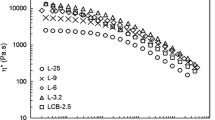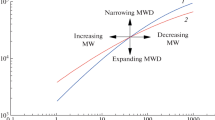Abstract
The stress dependencies of the steady-state viscosity η and, particularly, that of the steady-state elastic compliance J e of various linear isotactic polypropylenes (PP) and one long-chain branched PP are investigated using creep-recovery tests. The creep stresses applied range from 2 to 10,000 Pa. In order to discuss the stress-dependent viscosity η and elastic compliance J e with respect to the influence of the weight average molar mass M w and the polydispersity factor M w/M n the PP are characterized by SEC–MALLS. For the linear PP, linear steady-state elastic compliances \(J_{\rm e}^0 \) in the range of 10 − 5–10 − 3 Pa − 1 are obtained depending on the molar mass distribution. \(J_{\rm e}^0 \) of the LCB-PP is distinctly higher and comes to lie at around 10 − 2 Pa − 1. \(J_{\rm e}^0 \) is found to be independent of M w but strongly dependent on polydispersity. η and J e decrease with increasing stress. For the linear PP, J e as a function of the stress τ is temperature independent. The higher M w/M n the stronger is the shear thinning of η and the more pronounced is the stress dependence of J e. For the LCB-PP, the strongest stress dependence of η and J e is observed. Furthermore, for all PP J e reacts more sensitively to an increasing stress than η. A qualitative explanation for the stronger stress dependence of J e compared to η is given by analyzing the contribution of long relaxation times to the viscosity and elasticity.













Similar content being viewed by others
Notes
According to the literature stereo defects generated by the synthesis with metallocene catalysts are responsible for interrupting the length of the crystallisable, isotactic sequences and, thus, lowering T m (Phillips and Wolkowicz 1996).
Creep-recovery experiments at higher stresses could not be performed because edge fracture of the sample occurs during the experiment.
The \(J_{\rm e}^0 \) values given by Patham and Jayaraman lie in the order of 5·10 − 4 Pa − 1 for all the three mLLDPE investigated, and thus, in the range of LCB-mLLDPE (Resch et al. 2009). All other quantities presented in their paper confirm the hypothesis that their materials contain LCB: 1) The δ(∣G*∣)-plots show a deflection point, 2) η 0 is higher than expected for linear products at the given M w, and 3) the activation energy E a lies in the range of 37 to 41 kJ mol − 1, whereas for mLLDPE values around 33 kJ mol − 1 are expected (e.g. Wood-Adams 2001).
References
Agarwal PK, Plazek DJ (1977) Shear creep recovery behaviour of IUPAC low-density polyethylenes. J Appl Polym Sci 21:3251–3260
Auhl D, Stange J, Münstedt H, Krause B, Voigt D, Lederer A, Lappan U, Lunkwitz K (2004) Long-chain branched polypropylenes by electron beam irradiation and their rheological properties. Macromolecules 37:9465–9472
Auhl D, Ramirez J, Likhtman AE, Chambon P, Fernyhough C (2008) Linear and non-linear shear flow behavior of monodisperse polyisoprene melts with a large range of molecular weights. J Rheol 52:801–835
Dealy JM, Larson RG (2006) Structure and rheology of molten polymers. Carl Hanser Verlag, München
Gabriel C, Kaschta J (1998) Comparison of different shear rheometers with regard to creep and creep recovery measurements. Rheol Acta 37:358–364
Gabriel C, Münstedt H (1999) Creep recovery behavior of metallocene linear low-density polyethylenes. Rheol Acta 38:393–403
Gabriel C, Münstedt H (2002) Influence of long-chain branches in polyethylenes on linear viscoelastic flow properties in shear. Rheol Acta 41:232–244
Gabriel C, Kaschta J, Münstedt H (1998) Influence of molecular structure on rheological properties of polyethylenes I. Creep recovery measurements in shear. Rheol Acta 37:7–20
Gahleitner M (2001) Melt rheology of polyolefins. Prog Polym Sci 26:895–944
Graessley WW (1974) The entanglement concept in polymer rheology. Springer, Heidelberg
Graessley WW (2003) Viscoelasticity and flow in polymeric liquids. In: Mark J, Ngai K, Graessley WW, Mandelkern L, Samulski E, Koenig J, Wignall G (eds) Physical properties of polymers, 3rd edn. Cambridge University Press, Cambridge, pp 153–208
Graessley WW, Roovers J (1979) Melt rheology of four-arm and six-arm star polystyrenes. Macromolecules 12:959–965
Gross B (1954) Mathematical structure of the theories of viscoelasticity. Hermann, Paris
Hughes RH (1969) The determination of the isotacticity of polypropylene in the 90–100% range by infrared spectroscopy. J Appl Polym Sci 13:417–425
Kaschta J, Schwarzl FR (1994a) Calculation of discrete retardation spectra from creep data—I. Method. Rheol Acta 33:517–529
Kaschta J, Schwarzl FR (1994b) Calculation of discrete retardation spectra from creep data—II. Analysis of measured creep curves. Rheol Acta 33:530–541
Lagendijk RP, Hogt AH, Buijtenhuijs A, Gotsis AD (2001) Peroxydicarbonate modification of polypropylene and extensional flow properties. Polymer 42:10035–10043
Laun HM (1987) Orientation of macromolecules and elastic deformations in polymer melts. Influence of molecular structure on the reptation of molecules. Prog Colloid & Polym Sci 75:111–136
Lohse DJ, Milner ST, Fetters LJ, Xenidou M, Hadjichristidis N, Roovers J, Mendelson RA, Garcia-Franco CA, Lyon MK (2002) Well-defined, model long chain branched polyethylene. 2. Melt rheological behavior. Macromolecules 35:3066–3075
Minoshima W, White JL, Spruiell JE (1980) Experimental investigations of the influence of molecular weight distribution on the rheological properties of polypropylene melts. Polym Sci Eng 20:1166–1176
Orbon SJ, Plazek DJ (1979) Recoverable compliance of a series of bimodal molecular weight blends of polystyrene. J Polym Sci, Polym Phys Ed 17:1871–1890
Patham B, Jayaraman K (2005) Creep recovery of random ethylene-octene copolymer melts with varying comonomer content. J Rheol 49:989–999
Phillips RA, Wolkowicz MD (1996) Structure and morphology. In: Moore EP Jr (ed) Polypropylene handbook. Carl Hanser Verlag, München, pp 287–303
Plazek DJ (1984) The creep behaviour of amorphous polymers. In: Ngai KL, Wright GB (eds) Relaxation in complex systems. Naval Research Laboratory, Washington, pp 83–109
Plazek DJ, O’Rourke VM (1971) Viscoelastic behavior of low molecular weight polystyrene. J Polym Sci, A-2 Polym Phys 9:209–243
Plazek DJ, Raghupathi N, Kratz RF, Miller WR (1979) Recoverable compliance behavior of high-density polyethylenes. J Appl Polym Sci 24:1305–1320
Resch JA, Stadler FJ, Kaschta J, Münstedt H (2009) Temperature dependence of the linear steady-state shear compliance of linear and long-chain branched polyethylenes. Macromolecules 42:5676–5683
Roovers J, Graessley WW (1981) Melt rheology of some model comb polystyrenes. Macromolecules 14:766–773
Scheve B, Mayfield JW, DeNicola AJ (1986) Polypropylene mit freier Langkettenverzweigung, Verfahren zur Herstellung und Verwendung davon. EP0190889
Simak P (1988) Spektroskopische Bestimmung von Ethylen in Ethylen-Propylen-Copolymeren. Kunstst 78:234–236
Stadler FJ, Bailly C (2009) A new method for the calculation of continuous relaxation spectra from dynamic-mechanical data. Rheol Acta 48:33–49
Stadler FJ, Piel C, Klimke K, Kaschta J, Parkinson M, Wilhelm M, Kaminsky W, Münstedt H (2006a) Influence of type and content of various comonomers on long-chain branching of ethene/α -olefin copolymers. Macromolecules 39:1474–1482
Stadler FJ, Piel C, Kaschta J, Rulhoff S, Kaminsky W, Münstedt H (2006b) Dependence of the zero shear-rate viscosity and the viscosity function of linear high density polyethylenes on the mass-average molar mass and polydispersity. Rheol Acta 45:755–764
Stange J (2006) Einfluss rheologischer Eigenschaften auf das Schäumverhalten von Polypropylenen unterschiedlicher molekularer Struktur. Shaker Verlag, Aachen
Sun T, Brant P, Chance RR, Graessley WW (2001) Effect of short chain branching on the coil dimensions of polyolefins in dilute solution. Macromolecules 34:6812–6820
Wolff F, Resch JA, Kaschta J, Münstedt H (2010) Comparison of viscous and elastic properties of polyolefin melts in shear and elongation. Rheol Acta 49:95–103
Wood-Adams PM (2001) The effect of long chain branches on the shear flow behavior of polyethylene. J Rheol 45:203–210
Acknowledgements
The authors would like to thank the German Research Foundation (DFG) for the financial support of this work. The contributions of Mrs. Inge Herzer, Mrs. Marika Sturm, and Mrs. Michelle Malter regarding the SEC–MALLS, the IR-spectroscopy, and the DSC measurements are gratefully acknowledged. Prof. Dr. Florian Stadler (School of Semiconductor and Chemical Engineering, Chonbuk National University) deserves acknowledgement for the calculation of the relaxation spectrum and its evaluation concerning η 0 and \(J_{\rm e}^0 \).
Author information
Authors and Affiliations
Corresponding author
Rights and permissions
About this article
Cite this article
Resch, J.A., Kaschta, J., Wolff, F. et al. Influence of molecular parameters on the stress dependence of viscous and elastic properties of polypropylene melts in shear. Rheol Acta 50, 53–63 (2011). https://doi.org/10.1007/s00397-010-0502-5
Received:
Revised:
Accepted:
Published:
Issue Date:
DOI: https://doi.org/10.1007/s00397-010-0502-5




